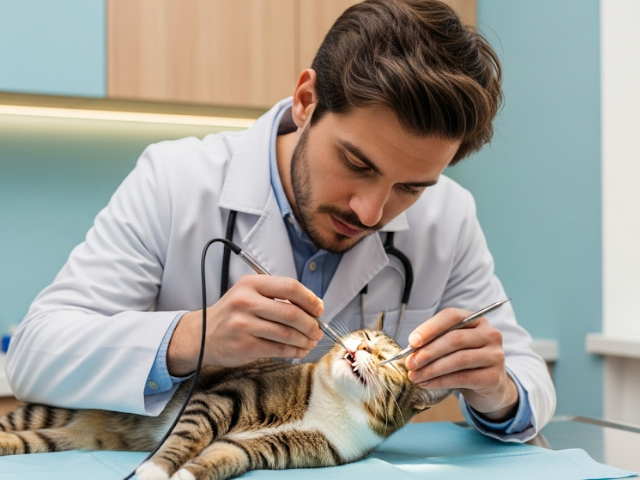Have you ever bent down to scratch your cat’s chin and felt a sudden nip? That playful nip is a reminder of how tough cats’ teeth are. And now you wonder, how many teeth do house cats have, and how can you keep their smiles shining? You’ll learn these and more in this article.

Dentition is the order, kind, and number of an animal’s teeth. Each of a cat’s teeth has a specific job to do for eating and playing. Veterinarians will tell you dental formulas. It may sound hard, but it’s just a way to count the teeth on the top and bottom jaws.
An average adult cat’s dental formula looks like this:
I3/3, C1/1, P3/2, M1/1
Where:
If you add up all those little symbols, you get 30 teeth. That’s why most guide notes say that 30 is the total number of teeth house cats generally have.
Kittens are born without any teeth. Their first little teeth start to come in when they are around two to six weeks old. By six to eight weeks, they usually have a complete set of 26 tiny, sharp teeth.
As they grow, around three to four months old, these baby teeth begin to fall out to make space for their stronger adult teeth. By the time they are six to seven months old, most cats will have 30 permanent teeth.
Table: Age vs. Approximate Tooth Count
Age Range | Tooth Count |
2-6 weeks | 0-26 baby teeth |
6-8 weeks | 26 baby teeth (peak) |
3-4 months | Transition phase |
6-7 months | 30 permanent teeth |
The transformation happens quickly. One day, your kitten is chewing on toys with tiny points, and the next day, they’re cutting kibble with their full-grown teeth. It’s an epic rite of passage you won’t want to miss.
There are four types of feline teeth, and each has a specific purpose. Some are for cutting fur, while others are for breaking or piercing bones. Here is what makes up that little smile.
Table: Tooth Type, Count, Primary Function
Tooth Type | Count (both sides) | Primary Function |
Incisors | 6 | Grooming, nibbling |
Canines | 4 | Grasping, puncturing |
Premolars | 10 | Slicing meat |
Molars | 4 | Crushing, grinding |
These are the minuscule teeth located at the forefront of your kitty’s mouth. There are six on the top and six on the bottom. Their main job is doing delicate work other than chewing. Your cat uses them to groom itself, pick up things, and nibble on food or treats.
The canines are long, sharp teeth found at the top and the bottom of your cat’s mouth. These are the four iconic teeth you see when your cat stretches its mouth. Their primary job is to grab and hold onto prey. At home, they are used to grabbing toys and, at times, to giving a firm, warning nip.
The premolars are behind the canines. A fully grown cat has six choppers on the upper jaw and four on the lower jaw. These teeth are sharp and serrated, which makes them great for cutting and shearing food into smaller, easier-to-swallow pieces. These side teeth are what your cat uses to chew on kibble.’
Molars are the teeth that sit at the very end of the mouth. There are two on top and two on the bottom of your cat. These are flatter than the premolars and are used to crush and grind food, like kibble or even bones in a raw diet.

Most cats have 30 teeth, but some factors can change the count. Here are a few reasons why your whiskered furball might have extra or missing teeth:
Some cats are more likely to have dental variations. Brachycephalic cat breeds, like Persians and Himalayans, are more prone to dental problems due to their constricted jaw structure. This overcrowding can lead to misaligned or missing teeth. From birth, a cat’s genetics significantly influence its dental health.
Some cats are born with congenital conditions that affect the number of teeth they have.
As cats age, the number of their teeth can change. A hit to the face or jaw can knock out a tooth, but dental disease is often the main reason. Periodontal disease, which affects the gums and the bones that support the teeth, is one of the main reasons adult cats lose their teeth.
If you’re curious about how many teeth adult house cats generally have in strange situations, their genetics and health history can tell you.

Cats are masters at hiding pain. You might not notice a tooth is missing until your kitty refuses to eat or starts to drool. Beware of these warning signs:
If your cat has a toothache or has lost a tooth, you might see some of these symptoms:
Pain can affect your cat’s behavior. If your usually friendly cat becomes withdrawn or irritable, especially at mealtimes, keep an eye on them. If they don’t want to eat hard food or don’t want you to touch their head, that could also be a sign.
If you see a tooth on the floor or a new gap in your cat’s smile, it’s time for a vet visit. A veterinarian can determine why your cat lost a tooth and check for other problems, such as gum disease or an infection. Don’t assume that losing teeth is part of old age.
If you catch your cat’s tooth loss early, it will hurt less and cost you less. A quick trip to the vet can confirm the actual count and find underlying issues.

Regularly caring for your cat’s teeth is the first step to keeping them healthy. Here’s how to make dental hygiene feel like a bonding moment with your feline.
Good habits today will help you avoid pain tomorrow. You and your cat will both enjoy purring and playing without dental dramas.

Don’t let bad advice ruin your cat’s smile. Let’s break some myths:
It’s not true at all. Indoor cats eat different foods and live much longer than their wild ancestors. Plaque and tartar build up over time, causing painful periodontal disease. This infection can spread to other organs, such as the heart and kidneys, and make your kitty very sick.
Cats don’t usually experience tooth loss as they age. If an adult cat does lose a tooth, it typically indicates advanced dental disease. Healthy teeth in a healthy mouth should remain intact throughout their life.
Many popular treats don’t do much to clean teeth. In fact, starchy and sugary foods can lead to dental buildup. While some dental treats are effective, chewing on regular treats is not a substitute for brushing. Look for the Veterinary Oral Health Council (VOHC) seal and check the ingredients.
With the help of proper information, you can choose the best options for your cat’s teeth and gums.

Now that you know how many teeth house cats have and why it matters, it’s time to care for them properly. Check your cat’s teeth regularly during play. Lastly, track critical milestones, like the first baby tooth and the adult set at six months, paying attention to any missing or extra teeth.
Keep your cat’s smile bright. Take care of those pearly whites, and you both can enjoy a lifetime of healthy bites and warm cuddles.


One Response
Haha, dat van die ‘plotselinge beet’ herken ik zó! Mijn kat doet dat meestal als ik nét denk dat we een lief knuffelmoment hebben. Blijft fascinerend hoeveel tandjes er in zo’n klein bekkie passen.